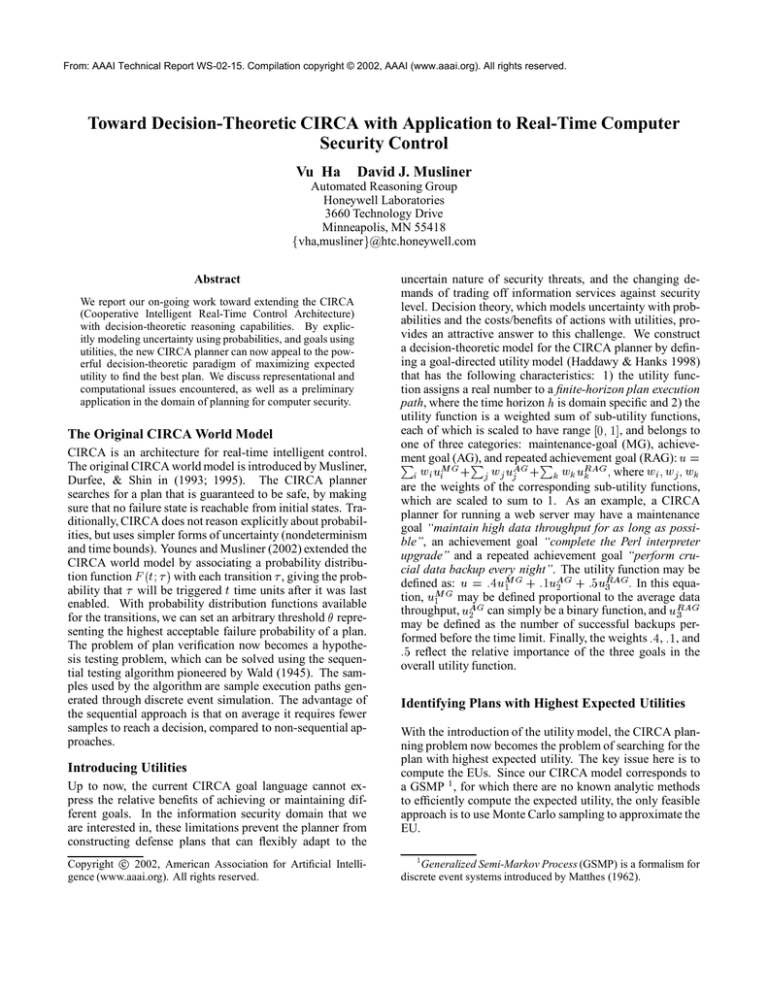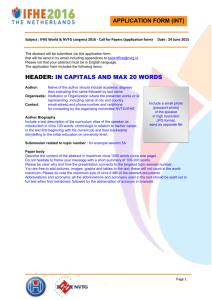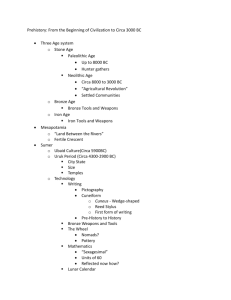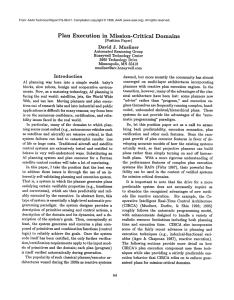
From: AAAI Technical Report WS-02-15. Compilation copyright © 2002, AAAI (www.aaai.org). All rights reserved.
Toward Decision-Theoretic CIRCA with Application to Real-Time Computer
Security Control
Vu Ha
David J. Musliner
Automated Reasoning Group
Honeywell Laboratories
3660 Technology Drive
Minneapolis, MN 55418
vha,musliner @htc.honeywell.com
Abstract
We report our on-going work toward extending the CIRCA
(Cooperative Intelligent Real-Time Control Architecture)
with decision-theoretic reasoning capabilities. By explicitly modeling uncertainty using probabilities, and goals using
utilities, the new CIRCA planner can now appeal to the powerful decision-theoretic paradigm of maximizing expected
utility to find the best plan. We discuss representational and
computational issues encountered, as well as a preliminary
application in the domain of planning for computer security.
CIRCA is an architecture for real-time intelligent control.
The original CIRCA world model is introduced by Musliner,
Durfee, & Shin in (1993; 1995). The CIRCA planner
searches for a plan that is guaranteed to be safe, by making
sure that no failure state is reachable from initial states. Traditionally, CIRCA does not reason explicitly about probabilities, but uses simpler forms of uncertainty (nondeterminism
and time bounds). Younes and Musliner (2002) extended the
CIRCA world model by associating a probability distribuwith each transition , giving the probtion function
ability that will be triggered time units after it was last
enabled. With probability distribution functions available
for the transitions, we can set an arbitrary threshold representing the highest acceptable failure probability of a plan.
The problem of plan verification now becomes a hypothesis testing problem, which can be solved using the sequential testing algorithm pioneered by Wald (1945). The samples used by the algorithm are sample execution paths generated through discrete event simulation. The advantage of
the sequential approach is that on average it requires fewer
samples to reach a decision, compared to non-sequential approaches.
Introducing Utilities
Up to now, the current CIRCA goal language cannot express the relative benefits of achieving or maintaining different goals. In the information security domain that we
are interested in, these limitations prevent the planner from
constructing defense plans that can flexibly adapt to the
The Original CIRCA World Model
uncertain nature of security threats, and the changing demands of trading off information services against security
level. Decision theory, which models uncertainty with probabilities and the costs/benefits of actions with utilities, provides an attractive answer to this challenge. We construct
a decision-theoretic model for the CIRCA planner by defining a goal-directed utility model (Haddawy & Hanks 1998)
that has the following characteristics: 1) the utility function assigns a real number to a finite-horizon plan execution
path, where the time horizon is domain specific and 2) the
utility function is a weighted sum of sub-utility functions,
, and belongs to
each of which is scaled to have range
one of three categories: maintenance-goal (MG), achievement goal (AG), and repeated achievement goal (RAG):
where
are the weights of the corresponding sub-utility functions,
which are scaled to sum to 1. As an example, a CIRCA
planner for running a web server may have a maintenance
goal “maintain high data throughput for as long as possible”, an achievement goal “complete the Perl interpreter
upgrade” and a repeated achievement goal “perform crucial data backup every night”. The utility function may be
In this equadefined as:
may be defined proportional to the average data
tion,
can simply be a binary function, and
throughput,
may be defined as the number of successful backups performed before the time limit. Finally, the weights , , and
reflect the relative importance of the three goals in the
overall utility function.
Copyright c 2002, American Association for Artificial Intelligence (www.aaai.org). All rights reserved.
*
"! # %$& $ $)
'(! # +*, *-.'(! /10 23"4 ! # 056 '(7 ! # 0 89 :-.'(! 0
"4 !
;'(7 !
08
$ *
< :-.'(!
0 2 0=
Identifying Plans with Highest Expected Utilities
With the introduction of the utility model, the CIRCA planning problem now becomes the problem of searching for the
plan with highest expected utility. The key issue here is to
compute the EUs. Since our CIRCA model corresponds to
a GSMP 1 , for which there are no known analytic methods
to efficiently compute the expected utility, the only feasible
approach is to use Monte Carlo sampling to approximate the
EU.
1
Generalized Semi-Markov Process (GSMP) is a formalism for
discrete event systems introduced by Matthes (1962).
Monte Carlo Estimation of EU
10000
*
6 3
7
2 7 * 2 7 *
* 2 7 6 Sequential Methods for Identifying Best Plans
The above sample upper bound of + - /. is applicable
for any random variable with range
, which is important for our analysis because is a complex function and
will most likely not observe known parametric forms such
as uniform or Gaussian. The downside of this generality is
that
upper bound is rather high: for .01 error margin and
1 32 this
confidence (
), we need to have a sample of size
200,000. One possible way to cut down on the number of
samples is to appeal to sequential analytic techniques (see
e.g. (Younes & Musliner 2002)). Unfortunately, there is
no known effective sequential method to estimate the mean
of a random variable unless parametric assumptions are
made about . Our solution is based on the observation that
in Step 4 in Algorithm 1, what we really are interested in
this step is whether the current plan 4 is inferior&to% the cur, which
rent best plan, i.e.
54 6 7 "#$
is clearly a hypothesis testing problem. If we can quickly
determine, via a sequential acceptance sampling procedure
that 4 is inferior to the current best plan, there is no need
to continue estimating the EU of 4 ; the algorithm can move
on to the next plan. One scenario where this technique does
not work well is when successive plans are of increasingly
better quality. Nevertheless, in our experiments so far, the
best plan is identified after only examining a few plans, due
to the strength of our heuristic algorithm, and thus from that
point on we are able to save a significant amount of time on
estimating utilities. Figure 1 illustrates these savings.
In order to add the capability to reason with utility, we
need to make several modifications to the existing CIRCA
planner. The most significant change is the elimination of
preemptive actions, which are meant to make failure states
unreachable. In the decision-theoretic model, failure states
8
098
( &
< 100
10
&% ')( .
1. Set ! "#$
2. Generate a plan * . Simulate the execution of * up to time
horizon , compute the utility of the resulting path.
3. Repeat the above step for ,+ ! - /. times, compute
the average utility
. If 0 ! "#$ &% , set
&
%
! "#$
, .
4. Go back to step 2. Continue until some stopping criterion
is true (e.g. there are no more plans, or plan time limit is
reached).
1000
Number of simulation runs
Failure
Inferior
Superior
Note that by definition, the utility function has range
,
and as a consequence, the utility of a plan is a random variable
. Ideally, we would like our estimate
of with range
to be within of the actual mean with probability
of at least , where and are small positive real numbers: . If denotes the variance
of (which is at most 1/4 because is bounded in
),
and denotes the mean of a -size sample of , we have
proved (by means of Chebyshev’s inequality) that this accuracy can be achieved with a sample of size .
The following algorithm finds the plan with highest expected
utility:
1
0
50
100
150
200
250
Plan Index
300
350
400
450
Figure 1: The number of simulations for 432 different plans
98 and for a computer security domain, with . The graph clearly shows that for a large percentage of
plans, the required number of simulation runs is less than
100, significantly less than the maximum number of runs,
which is 8000. Note that here we simultaneously check if
the probability of plan failure exceeds a threshold
0 98
098
+
are tolerated, as long as we don’t encounter them very often.
One consequence of this is that a large number of failurebound plans now make it to the EU simulation phase. This
issue raises the importance of simulation-guided backjumping. Currently, plans are generated via a depth-first exploration of the plan space. The problem with this procedure is
that if a mistake is made early in the planning process, that
mistake can be corrected only after all possible onward decision combinations have been explored. The obvious way to
overcome this problem is to look at the simulation traces that
lead a plan to failure, identify the earliest decision responsible for that failure, and backjump to correct that decision.
References
Haddawy, P., and Hanks, S. 1998. Utility models for goaldirected, decision-theoretic planners. Computational Intelligence
14(3).
Matthes, K. 1962. Zur Theorie der Bedienungsprozesse. In
Kožešnı́k, J., ed., Transactions of the Third Prague Conference
on Information Theory, Statistical Decision Functions, Random
Processes, 513–528. Liblice, Czechoslovakia: Publishing House
of the Czechoslovak Academy of Sciences.
Musliner, D. J.; Durfee, E. H.; and Shin, K. G. 1993. CIRCA: A
cooperative intelligent real-time control architecture. IEEE Transactions on Systems, Man, and Cybernetics 23(6):1561–1574.
Musliner, D. J.; Durfee, E. H.; and Shin, K. G. 1995. World
modeling for the dynamic construction of real-time control plans.
Artificial Intelligence 74(1):83–127.
Wald, A. 1945. Sequential tests of statistical hypotheses. Annals
of Mathematical Statistics 16(2):117–186.
Younes, H. L. S., and Musliner, D. J. 2002. Probabilistic plan
verification through acceptance sampling. In Proceedings of the
AIPS 2002 Workshop on Planning via Model Checking. Toulouse,
France: AAAI Press.





